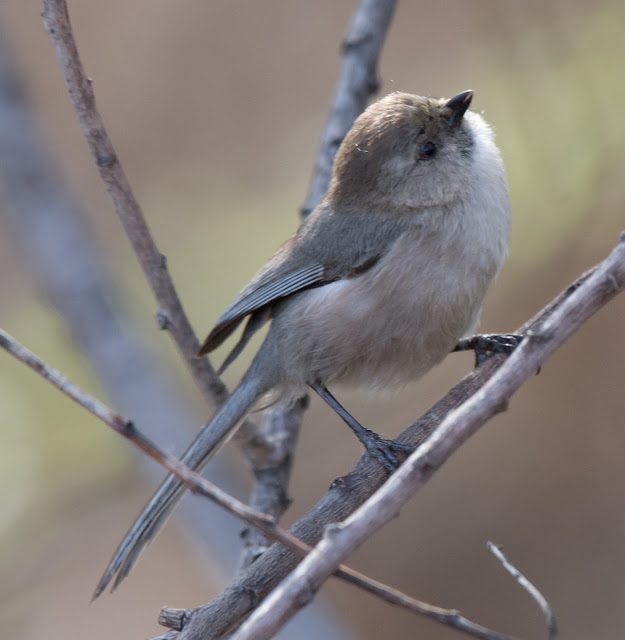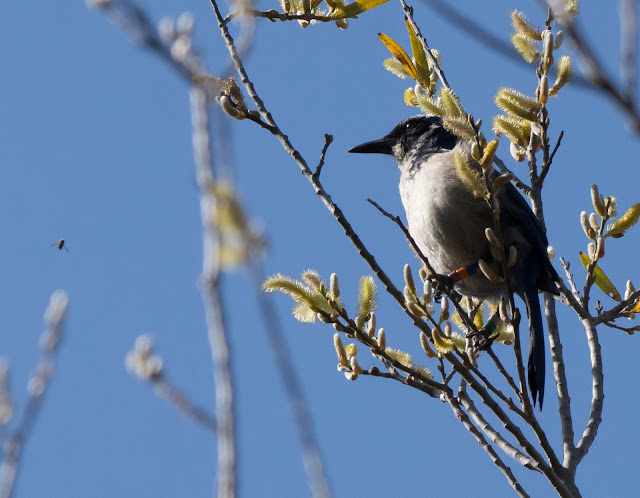The main target bird, the Island Scrub-Jay, was covered in my previous post, but I had a couple more to look for as well, but these birds are non-natives, and have established breeding populations in the United States and are ABA countable. So I figured that I might as well put some time and effort in trying to locate these other 2 species.
The first one is the Red-whiskered Bulbul, which is native to tropical Asia and was introduced to the United States. With a little research, I discovered that the Los Angeles County Arboretum and Botanical Gardens might be the best place to find this bird. It did not take long to find one either. As soon as I got out of my vehicle in the parking lot, the first thing I heard was Indian Peafowl, which everyone is familiar with, and the 2nd one was an unusual song that I had not heard before and it did not take long to pinpoint the source; a Red-whiskered Bulbul near the top of a tree in the parking lot. Once I got inside, I found out that they were quite numerous and they are very vocal, so it was not hard to locate many more.
Red-whiskered Bulbul
Allen's Hummingbird
Indian Peafowl were introduced to this site in the late 1800's and they are thriving, breeding, and well established at this location. Have always loved the colors of these large birds.
Indian Peafowl - Male
Female
A leucistic American Coot - rather attractive for a coot!
Bushtit - Sure looks different from those in Arizona
California Gull
California Towhee
Egyptian Goose
A hybrid goose of some sort
Great Basin Fence Lizard
Blue-gray Gnatcatcher
Cassin's Kingbird
Red-whiskered Bulbul
As mentioned in my previous post, I was captivated by all the Allen's Hummingbirds and the chance to get some respectable photos of them.
Indian Peafowl were introduced to this site in the late 1800's and they are thriving, breeding, and well established at this location. Have always loved the colors of these large birds.
Indian Peafowl - Male
Female
From this spot, I then traveled to the Sepulveda Basin Wildlife area and Balboa Lake, which are fairly close together and just separated by a golf course. And I got a nice assortment of birds there as well.
Bushtit - Sure looks different from those in Arizona
California Gull
California Towhee
Egyptian Goose
A hybrid goose of some sort
Song Sparrow (ssp heermanni) - Much different than what we have in Arizona
Found a couple of lizards as well and not being real familiar with the species found in California, I had to rely on some of the experts on iNaturalist.org to supply an ID for them.
Western Fence Lizard
The Santa Cruz Island trip was wedged in between my arrival date and my departure date. (See previous post.) On my last day I had enough time to chase another countable non-native bird that is established in California; the Spotted Dove. I had spent a lot of time researching in the weeks before my visit, to find out where it was being reported this year. Incredibly, it was not being reported at any eBird Hotspots, so I had to make my way to the intersection of a couple of cross streets to begin my trek. Who says you can't do any good birding at Home Depot or Target? I had to walk up and down a street behind those two businesses that was lined with residences on one side. Birding in and around a residence has to be done a bit judiciously. Most people are not fond of people with binoculars and a camera probing their yards. I walked this street from one end to the other and finally decided I was going to have to give up. About a block from the car on my return, I saw a Mourning Dove fly up to an electrical line and shortly after, another dove-like bird fly to a line nearby. Got my binoculars up and sure enough, there was a Spotted Dove. Quickly took a couple of distant photos and then tried to get to an area with a closer view and by that time it was gone. Talk about a last minute find!
Spotted Dove
I had time for one more stop before heading back to the airport in Burbank, so I headed to the San Gabriel River Parkway Nature Trail. Nothing new, but got to view and photograph a couple of cool birds.
Cassin's Kingbird
California Scrub-Jay
Yes, the time flew by very quickly, but being able to notch a few more life birds made the trip all worthwhile. New adventures await me in the next few months of 2017. Hope they are successful.


















































